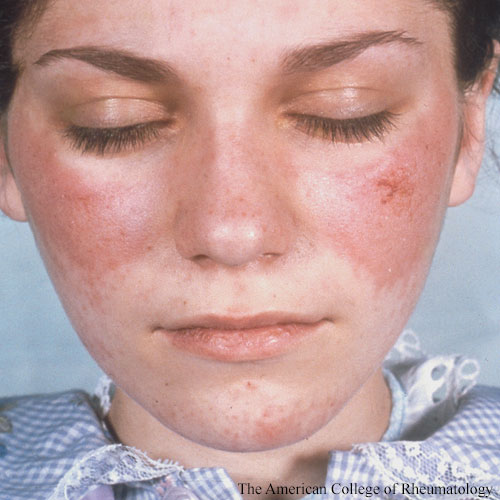 SAN DIEGO—The proposed classification criteria for systemic lupus erythematosus (SLE), supported but not yet approved by the ACR and EULAR, were debuted on Nov. 7 at the 2017 ACR/ARHP Annual Meeting. An international steering committee developed and validated the criteria, with patient input and the consensus of more than 150 global SLE experts.
SAN DIEGO—The proposed classification criteria for systemic lupus erythematosus (SLE), supported but not yet approved by the ACR and EULAR, were debuted on Nov. 7 at the 2017 ACR/ARHP Annual Meeting. An international steering committee developed and validated the criteria, with patient input and the consensus of more than 150 global SLE experts.
Rheumatology researchers referred to both the 1997 ACR revised criteria and 2012 Systemic Lupus International Collaborating Clinics (SLICC) criteria when developing the new criteria, said Martin Aringer, MD, steering committee co-chair and chief of rheumatology at University Medical Center Carl Gustav Carus in Dresden, Germany.1 The committee set ambitious goals for the new criteria: to achieve higher sensitivity and specificity than previous criteria, account for lupus heterogeneity, incorporate manifestations to help identify early lupus patients and achieve worldwide consensus, using an expert-driven, data-driven methodology.2
Classification criteria are designed to identify a homogeneous set of patients for inclusion in clinical trials and translational studies, not to diagnose patients. “Diagnosis is individual. We look for the perfect therapy based on the individual prognosis. For classification, the aim is totally different. In diagnosis, we are entitled to use all the information we can gather on an individual patient. For classification, it has to be a feasible set of objective criteria,” Dr. Aringer said.
Although sensitivity is extremely critical for diagnosis to select therapies, it can be annoying in classification, because it is acceptable to exclude one or two patients from a large trial, Dr. Aringer said. “Diagnosis can be questioned again if the disease does not perform the way you expect, but in classification, you typically cannot go back and change the inclusion or exclusion. So specificity is very important.”
In classification, common features are most important, said Dr. Aringer. Although each lupus patient is unique, all have autoantibodies to nuclear antigens (ANA), as well as many other autoantibodies, and evidence of immune complex deposition from histology to complement to interferon signature. This leads to many different organ manifestations in SLE.
“ANA has very high sensitivity, but its specificity is actually pretty low. For anti-Smith antibodies, it’s the other way around. So it doesn’t make sense to have them side by side in the criteria,” said Dr. Aringer. They hypothesized that ANA would be the entry criterion and then tested if that was feasible.
Many conditions have overlapping features with SLE, “but if two of these attributes are found together, especially in a patient who also has autoantibodies, it’s usually SLE,” he said.
The committee agreed not to count a feature when it is more likely due to another condition and to create weighted criteria. Example: Manifestations, such as lupus nephritis, carry a higher score than less common skin features. If the score is 10 or higher, the patient is classified as having SLE.
Rigorous, Detailed Process
The committee wanted to reduce bias and circular reasoning, which could affect the criteria’s validity and viability, said co-chair Sindhu Johnson, MD, PhD, director of the scleroderma program at the University of Toronto.3 In the past, the same experts derived the criteria and then submitted cases to test them, she said. Separate panels of international experts, including rheumatologists, dermatologists, nephrologists and pediatricians, were recruited for each phase. SLE patients were surveyed to find out what symptoms they experienced early in their disease.
Experts nominated criteria that distinguish early from established disease. “We also asked them to think more broadly: Could these criteria also be used for juvenile-onset SLE? Or to identify established disease, but also early disease?” said Dr. Johnson. They found that manifestations of both early and established SLE, such as autoantibodies, specific renal features and skin manifestations, are also seen in mimickers. In addition, 85% of the experts said they would positively classify a patient if renal pathology alone showed lupus nephritis.
Looking at data from early SLE cohorts, “it appears that a number of classical lupus manifestations do distinguish SLE from mimickers, notably kidney disease, oral ulcers, pleuritis and alopecia,” she said.4 An interesting new finding was that non-classical, less specific manifestations, such as arthralgia, fever and fatigue, also distinguish early SLE from mimickers. “Finally, we looked to the patients. They also reported arthralgia, fever and fatigue as manifestations they experienced early in their disease.”5
A panel of SLE experts reviewed the criteria in development. Their recommendations included developing precise definitions for each criterion and clustering criteria related to the same organ systems into domains or buckets. Both recommendations were validated by the committee and applied.
“Because they are interrelated, it would be inappropriate to doubly count criteria within a domain,” she added. After ranking and scoring by a different expert panel, the criteria were tested in a derivation cohort and found to have a sensitivity of 98% and a specificity of 97%—higher than both the 1997 ACR and 2012 SLICC criteria, she said. The criteria will now be validated against a large cohort.
How to Use the Criteria
The development team’s goal is for the criteria to include a mobile app and online tool that defines each criterion and adds up the patient’s score, said Karen Costenbader, MD, director of the lupus program at Brigham and Women’s Hospital in Boston. She showed the audience how to score several patient cases.
“Within each domain, there is a system of criteria in ascending order of importance. You only count the most heavily weighted criterion within that domain,” said Dr. Costenbader. “We are relying on your clinical acumen. If you feel there’s a more likely explanation for this patient to have a certain manifestation, you would not score it. If you think it’s as likely to be SLE as something else, then score it.”
Despite their many strengths, these criteria have some limitations, so discussion is welcome, she said.
“SLE is a complex, heterogeneous disease with many overlap syndromes. There is also incomplete lupus, pre-lupus, cutaneous-only lupus and early lupus,” said Dr. Costenbader. Patients with overlap syndromes may be classified as SLE if they meet the criteria, but excluded in specific studies. “Also, newer biomarkers and assays, such as complement deposition products and interferon signatures, may be very helpful in the classification of SLE, but they’re not widely available at this time.”
Susan Bernstein is a freelance journalist based in Atlanta.
References
- Petri M, Orbai AM, Alarcon GS, et al. Derivation and validation of systemic lupus international collaborating clinics classification criteria for systemic lupus erythematosus. Arthritis Rheum. 2012 Aug;64(8):2677–2686.
- Aringer M, Dorner T, Leuchten N, et al. Toward new criteria for systemic lupus erythematosus: A standpoint. Lupus. 2016 May;25(8):805–811.
- Singh JA, Solomon DH, Dougados M, et al. Development of classification and response criteria for rheumatic diseases. Arthritis Rheum. 2006 Jun;55(3):348–352.
- Touma Z, Costenbader KH, Johnson S, et al. Do patients with SLE at onset differ from mimickers? A comparison of clinical and serological manifestations in a multicenter cohort to inform the development of new classification criteria for SLE. Ann Rheum Dis. 2016;75(suppl 2):558.
- Leuchten M, Milke B, Winkler-Rohlfing B, et al. Early symptoms of systemic lupus erythematosus (SLE) recalled by 337 SLE patients. Ann Rheum Dis. 2016;75(suppl 2):313.
Proposed Draft Criteria
Here are the proposed ACR/EULAR Classification Criteria for SLE with scores in parentheses
Entry Criterion: History of a positive ANA BY Hep-2 immunofluorescence >1:80.
Opening Statements
- For each criterion, do not score if a more likely cause for the symptom exists.
- Occurrence of a criterion on at least one occasion is sufficient.
- Criteria need not occur simultaneously.
- At least one clinical criterion must be present.
- Within each domain, only the highest weighted criterion is counted toward the total score.
Constitutional Domain
- Unexplained fever >38.3 C (2)
Muco-Cutaneous Domain
- Non-scarring alopecia (2)
- Oral ulcers (2)
- Sub-acute cutaneous or discoid lupus (4)
- Acute cutaneous lupus (6)
Arthritis Domain
- Synovitis in two or more joints or tenderness in two or more joints or ≥30 minutes of morning stiffness (6)
Neurologic Domain
- Delirium (2)
- Psychosis (3)
- Seizure (5)
Serositis Domain
- Pleural or pericardial effusion (5)
- Acute pericarditis (6)
Hematological Domain
- Leukopenia (3)
- Thrombocytopenia (4)
- Autoimmune hemolysis (4)
Renal Domain
- Proteinuria >0.5g 24 hours (4)
- Renal biopsy with Class II or V lupus nephritis (8)
- Renal biopsy with Class III or IV lupus nephritis (10)
Antiphospholipid Domain
- Present (anti-cardiolipin antibody positive with medium or high units, or anti-β2-GP1 positive or lupus anticoagulant positive) (2)
Complement Proteins Domain
- Low C3 or Low C4 (3)
- Low C3 and Low C4 (4)
Highly Specific Antibodies Domain
- Anti-dsDNA antibody (6)
- Anti-Smith antibody (6)

